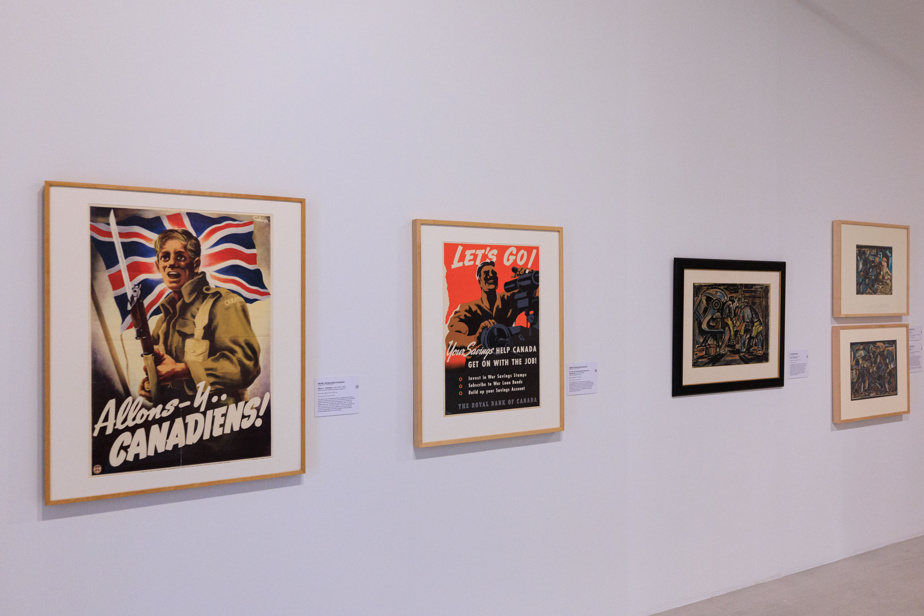The Joliette Art Museum (MAJ) is a highly recommended destination for art lovers this fall. Six exhibitions meet our expectations of diversity and substance. With a fascinating deployment on abstraction in Quebec before the emergence of the Automatists, produced by art historian Esther Trépanier, a deserved tribute to Rita Letendre and two spaces devoted to Aboriginal art.
It took Esther Trépanier three years to complete a colossal curatorial task on a little-known page in the history of abstraction in Quebec. The former professor and former director general of the Musée national des beaux-arts du Québec (2008-2011) wanted to celebrate four Montreal artists of the 1940s who had fallen into oblivion after the emergence, not to say the outburst, automation, in 1948.
Fritz Brandtner (1896-1969), Marian Dale Scott (1906-1993), Henry Rowland Eveleigh (1909-1999) and Gordon Webber (1909-1965) were avant-garde modernists indirectly propelled into the ruts of the history of the art by Borduas and his followers. ” As saying [l’historien de l’art] François-Marc Gagnon, the avant-garde does not unite, it separates”, slips Esther Trépanier.

PHOTO HUGO-SÉBASTIEN AUBERT, THE PRESS
View of the exhibition concocted by Esther Trépanier
The idea for the exhibition was born following the purchase in 2015, by the Montreal Museum of Fine Arts (MMFA), of the painting War Commentary, painted in 1942 by Eveleigh and dealing with the Sino-Japanese War (1937-1945). A cubist and surrealist montage, with references to Guernica, of a bombing scene.
“I realized that Brandtner, Scott, Webber and Eveleigh had exhibited regularly, notably at the MMFA, in Toronto and elsewhere in the 1940s,” says Ms.me Trepanier. Thanks to the articles of art critics, we see that they considered themselves and were perceived as abstract artists, abstraction being able to be gestural, geometric or inspired by reality. »

PHOTO HUGO-SÉBASTIEN AUBERT, THE PRESS
War Commentary1942, Henry Eveleigh
The historian researched these artists, which resulted in the writing of a 270-page book titled Scott, Brandtner, Eveleigh, Webber: revisiting 1940s Montreal abstraction. Fascinating work whose content is declined in the exhibition with works from private collections and major Quebec and Canadian museums, distributed in four rooms.
The exhibition includes war posters that these humanist, anti-fascist painters produced for Ottawa at the start of the Second World War, these artists constantly questioning the social role of art. It is fascinating to follow their careers in this luminous journey that Esther Trépanier carried out with great energy, despite her health problems. This is an exhibition, a work and major research for understanding the history of abstraction in Quebec. Hats off, Madam Trepanier!
The exhibition is accompanied, independently, by a hanging of five works from the museum’s collection entitled modern women. Five oils produced between 1937 and 1963 by Montreal painters Irène Senécal, Lilias Torrance Newton, Agnès Lefort, Ghitta Caiserman and Rita Briansky.
Aboriginal art
A mural has been created in the front room of the museum, where children create plasticine works. Mirwatisiwin is signed by Marie-Claude Néquado, an Atikamekw artist from Manawan who succeeds the artist Eruoma Awashish. “This wall now belongs to the Native Friendship Center of Lanaudière, says Jean-François Bélisle, general manager of MAJ. The mural will change every two years. The new artist will be chosen by the previous one. »

PHOTO HUGO-SÉBASTIEN AUBERT, THE PRESS
The mural Mirwatisiwinby Marie-Claude Néquado, in the schoolchildren’s work room
Mirwatisiwin is dedicated to the healing process. With two women dressed in traditional clothes, a dream catcher and symbols of medicinal plants. The room is lit at all times so that the mural is always visible from the outside. The Musée d’art de Joliette has intensified its ties with the local Aboriginal community since the death of Joyce Echaquan.
One of the large halls of the museum is reserved for another Aboriginal artist, Faye HeaveyShield, a member of the Blackfoot Confederacy and the Kanai (Blood) First Nation, in Alberta. This first museum solo by the 69-year-old artist in Quebec is scripted with an atmosphere of contemplation. We approach, in photography, a tribute to the elders and an allusion to the past of pain. Featuring a large portrait of Faye HeavyShield’s grandmother alongside photographs (in similar attire) of her two daughters and granddaughter. The photo of his mother and his are missing, the two generations who experienced the horrors of residential schools which broke the emotional bond of marriage.

PHOTO HUGO-SÉBASTIEN AUBERT, THE PRESS
On the right, the tapestry Koohiaaknear silkscreen Morning Glow, 1972
A posthumous tribute is also paid to Rita Letendre, who died on November 20, 2021. With some twenty works by the Abenaki Canadian painter, paintings from the 1950s to the 2000s, and Koohiaakthe only tapestry she made (with the Grimal workshop, in 1976) from a preparatory drawing, itself exhibited.
-

PHOTO HUGO-SÉBASTIEN AUBERT, THE PRESS
The Impatients space
-

PHOTO HUGO-SÉBASTIEN AUBERT, THE PRESS
The Good Shepherd1723, Antonio de Torres y Lorenzana
-

PHOTO PROVIDED BY THE MUSEUM
Embrace me1993-2013, Michel de Broin, heating element, controller
1/3
A space is devoted to works by artists from the organization Les impatients, who come to create at the museum two days a week. In the Hall of Sacred Art, the museum has installed an oil by the Mexican painter Antonio de Torres y Lorenzana (1666-1731), The Good Shepherd, acquired in 2012 then restored. “The extremely rare work had a large tear and was completely black,” says Jean-François Bélisle. We now see a lot of details. The canvas has since been the subject of a symposium. Finally, the museum has added to one of its picture rails the tiny installation Embrace me, by Michel de Broin. A heating thread that blushes then goes out, and which invites us to embrace these works brought together at MAJ and which offers us an extra soul.

